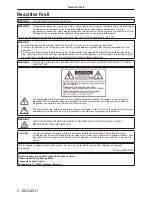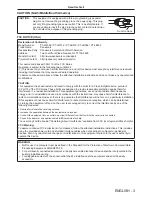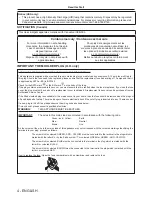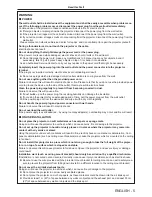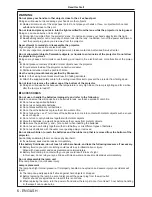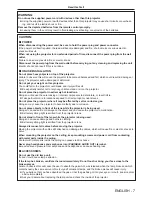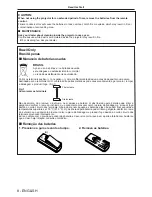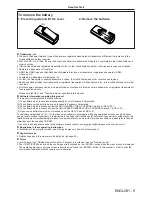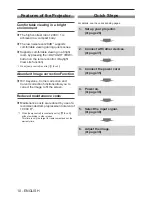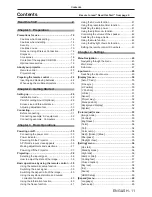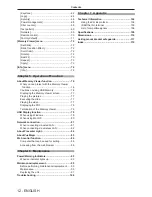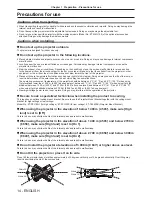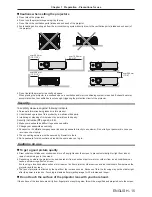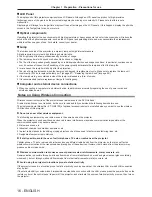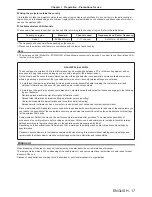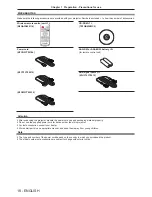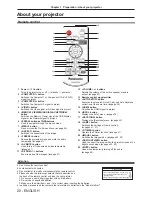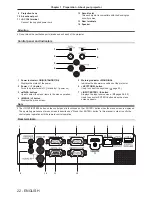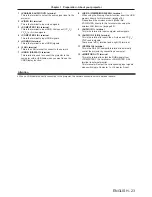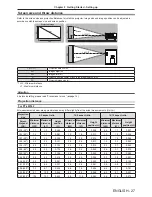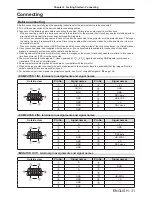
16 - ENGLISH
r
LCD Panel
The display unit of this projector comprises three LCD panels. Although an LCD panel is a product of high-precision
technology, some of the pixels on the projected image may be missing or constantly lit. Please note that this is not a
malfunction.
Displaying a still image for a longer time may result in an after-image on the LCD panels. If this happens, display the all white
screen in the Test pattern for an hour or more.
r
Optical components
Operating the projector in an environment with high temperature or heavy exposure to dust or tobacco smoke will reduce the
service life of the optical components, such as the LCD panel and polarizing plate, and may necessitate their replacement
within less than one year of use. For details, consult your dealer.
r
Lamp
The luminous source of the projector is a mercury lamp with high internal pressure.
A high pressure mercury lamp has following characteristics.
f
The brightness of the lamp will decrease by duration of usage.
f
The lamp may burst with sound or shorten life by shock or chipping.
f
The life of the lamp varies greatly depending on individual specificities and usage conditions. In particular, continuous use
over 6 hours and frequent on/off switching of the power greatly deteriorate the lamp and affect the lamp life.
f
In rare cases, the lamp burst shortly after the projection.
f
The risk of bursting increases when the lamp is used beyond its replacement cycle. Make sure to replace the lamp unit
consistently. (“When to replace the lamp unit” (
x
page 97), "Replacing the lamp unit" (
x
page 98))
f
If the lamp bursts, gas contained inside of the lamp is released in a form of smoke.
f
It is recommended to store replacement lamps for contingency.
r
Computer and external device connections
f
When connecting a computer or an external device, read this manual carefully regarding the use of power cords and
shielded cables as well.
Notes on Using Wireless Connection
Wireless connection function of the projector uses radio waves in the 2.4 GHz band.
A radio station license is not required, but be sure to read and fully understand the following items before use.
The wireless module (Model No.: ET-WML100) of optional accessories must be installed when you want to use the wireless
LAN function of this projector.
r
Do not use near other wireless equipment.
The following equipment may use radio waves in the same band as the projector.
When the projector is used near these devices, radio wave interference may make communication impossible, or the
communication speed may become slower.
f
Microwave ovens, etc.
f
Industrial, chemical and medical equipment, etc.
f
In-plant radio stations for identifying moving objects such as those used in factory manufacturing lines, etc.
f
Designated low-power radio stations
r
If at all possible, avoid the use of cellular phones, TV sets or radios near the projector.
Cellular phones, TV sets, radios and similar devices use different radio bands from the projector, so there is no effect on
wireless communication or the transmission and reception of these devices. However, radio waves from the projector may
produce audio or video noise.
r
Wireless communication radio waves cannot penetrate steel reinforcements, metal, concrete, etc.
Communication is possible through walls and floors made from materials such as wood and glass (except glass containing
wire mesh), but not through walls and floors made from steel reinforcements, metal, concrete, etc.
r
Avoid using the projector in locations prone to static electricity.
If the projector is used in a location prone to static electricity, such as on a carpet, the wireless LAN or wired LAN connection
may be lost.
If the static electricity or noise make it impossible to establish a connection with the LAN, please press the power button on the
remote control or the control panel to power off the projector, and eliminate the source of static electricity or noise, then turn on
the projector.
Chapter 1 Preparation - Precautions for use

